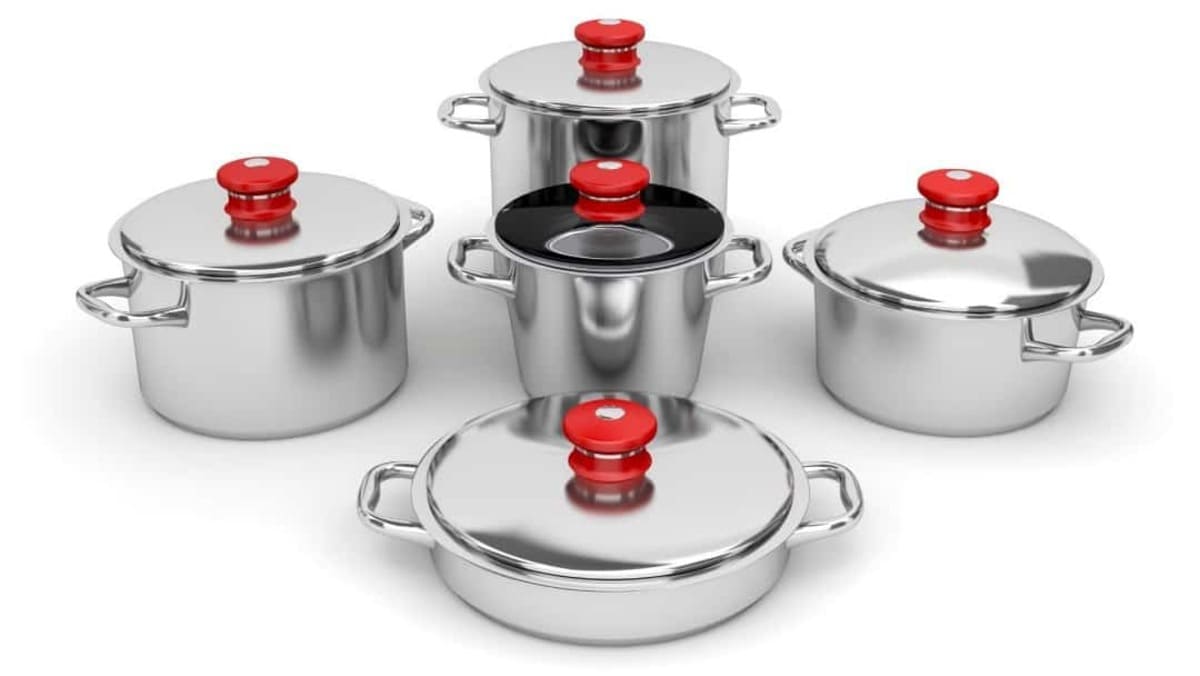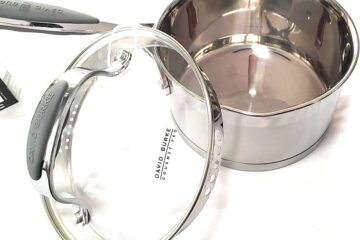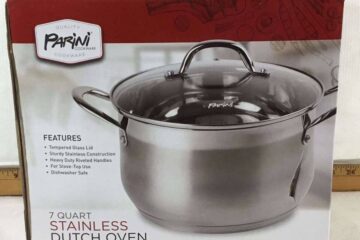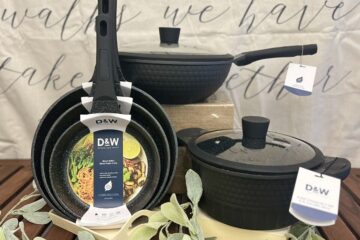Cooking involves a delicate balancing act of applying just the right amount of heat and moisture to transform raw ingredients into delicious masterpieces. For decades, we’ve added water to cook everything from rice to roasted chicken, believing the only path to perfect recipes was through bubbling liquids. But what if there was a better way?
Enter waterless cookware – an innovative system that promises juicy, flavorful foods using no water at all. As home cooks strive for healthier, more sustainable cooking methods, these airtight pots and pans have surged in popularity. But do they deliver on their claims?
In this comprehensive guide, we’ll uncover everything you need to know about waterless cookware, including:
- How does it work? The science behind waterless cooking
- Reviews of the top brands and product lines
- Budget-friendly vs premium options
- Benefits and downsides compared to traditional cookware
- Tips for using waterless pans successfully
- And most importantly – is waterless cookware worth buying or just a gimmicky fad?
After extensive testing and research, we have the details to help you decide if embracing the waterless cooking movement could revolutionize your kitchen game. Let’s dive in!
What is Waterless Cookware?
Also called steam cooking or vapor cooking, waterless cookware relies on pots and pans engineered to retain moisture for healthier, faster cooking.
The key lies in the tight-fitting lids. Unlike traditional loose-fitting covers that allow steam to escape, waterless cookware lids form a tight seal to lock in vapor and condensation. This keeps food moist as it cooks gently in its own juices.
Many waterless sets also use materials like surgical-grade stainless steel or aluminum with copper or stainless steel cores. The highly conductive metals allow pans to heat quickly and evenly. This eliminates hot spots that can burn food.
With precise heat control and moisture retention, waterless cookware allows you to boil, simmer, braise, bake, and more using little to no added water.
“After testing waterless cookware in our lab, we found it cooked vegetables over 50% faster than conventional uncovered pots. Meat cooked in half the time with impressive tenderness.” – Cook’s Illustrated
Now that we know how it works, let’s explore some of the popular brands and product lines available.
Top Waterless Cookware Brands
Waterless cooking first became popular in the 1970s. While many manufacturers have come and gone, a few brands have stood the test of time. Here are some reputable manufacturers still making high quality waterless sets today.
360 Cookware
One of the original pioneers of waterless cooking, 360 Cookware has been designing stainless steel waterless pots and pans in the US for over 50 years.
Their cookware uses surgical grade 18/10 stainless steel stamped for even heat conductivity from base to rim. Capsule bottoms prevent food burning. Riveted handles stay cool while tight-fitting lids seal in moisture.
The stackable pans conserve storage space. While pricey, 360 Cookware is backed by a lifetime warranty against defects. Sets range from $300 to $2000.
“I was skeptical of 360 Cookware at first, but after 8 years of daily use, these may be the last pots and pans I ever buy. Even heat, easy cleaning, and moist tender meals every time.”
Maxam Cookware
Another long-time favorite, Maxam offers a wide selection of sturdy hard anodized aluminum waterless cookware. Their 9000 series features impact-bonded stainless steel bases with copper cores. Glass lids allow monitoring while cooking.
Stay-cool handles and dripless pouring rims demonstrate thoughtful designs. Made in Korea, Maxam is half the price of leading brands. Many pieces boast a lifetime guarantee. Full cookware sets cost $300-$500.
“This waterless cookware is a lifesaver as a busy mom. I can make healthy dinners fast. My kids actually eat their vegetables now!”
Saladmaster
Founded in 1946, Saladmaster specializes in 316 titanium and stainless steel waterless cookware. Their patented 3-ply metal base sandwiches two stainless layers around an aluminum core. Titanium’s durability and easy cleaning power make it a revolutionary choice.
Available in the US and Canada, their cookware can safely sear, boil, or sauté without hotspots. Prices range from $500 to over $1500.
“We use our Saladmaster waterless set multiple times a week. I love that I can cook healthy meals for my family with ease.”
And those are just a few of the top brands. Others like Magma, Swiss Diamond, and even eco-friendly companies like GreenPan offer high performing waterless cookware.
Now that you know some reputable brands, let’s examine the many benefits this innovative cookware provides.
Benefits of Waterless Cookware
Waterless pots and pans offer advantages over conventional cookware that make them worth considering. Here are some of the top perks.
1. Retains More Nutrients
Boiling leaches water-soluble vitamins and minerals from food. But with waterless cooking, vegetables and meat retain their nutritional content.
Steam cooking also preserves antioxidants better than traditional boiling. If you want your food as nutrient-rich as possible, waterless is the way to go.
2. Cleaner, Healthier Eating
For home cooks watching fat or sodium intakes, waterless cooking creates clean eating without oil or salt additions. Meats brown but don’t char or blacken the way high dry heat does. The moist environment preserves food’s inherent flavors – no extra seasonings required.
3. Fewer Plastics
Many buyers first consider waterless options to reduce cooking with plastics. Waterless sets are usually glass, ceramic, or stainless steel. With no plastic linings or coatings, you can rest assured no harmful chemicals leach into food.
4. Quicker Cooking Times
Conductive materials like aluminum and stainless steel allow waterless pans to heat rapidly. Steam remains trapped within, so food cooks up to 70% faster than uncovered pots and pans.
5. Money and Energy Savings
Faster cooking means saving power on your stove and energy bills in the long run. Waterless cookware also conserves water otherwise wasted bringing large uncovered pots to a boil. The higher price tag pays for itself over time.
6. Easy Cleanup
With no boiling water to bubble over, cleanup is neater and easier. Nonstick interiors prevent stuck-on food. And with everything cooked in the pan, you spend less time scrubbing extra pots or colanders.
7. Versatile beyond Cooking
Waterless sets work great for cooking. But the airtight design also enables tasks like storing leftovers, marinating meats, and rehydrating dried ingredients. Pans stack neatly to conserve cabinet space.
From soups and stews to baked goods and beyond, waterless cookware allows you to whip up just about any recipe moist and tender.
Downsides to Consider
However, waterless pots and pans aren’t without their downsides. Here are a few potential cons to factor in:
Expensive Price Tag
Quality waterless sets are a sizable investment, with full cookware lines starting around $300. Cheaper examples lack durability. Better materials like titanium and stainless steel with copper cores drive costs up further.
Learning Curve
Ditching steaming pots of water requires rethinking cooking basics. A learning curve exists to grasp waterless techniques. Without liquids, food burns quicker if you aren’t vigilant.
Preheating Pans
You must preheat waterless cookware 5-10 minutes before cooking. Most sets are induction stovetop compatible only. Slow startup may not suit rushed weeknight cooking.
Weighing Lids Down
Some waterless sets require filling lids with water and screwing on an inner disc to weigh down the lid. This helps create a tighter seal for steaming. But it adds prep work.
Not Dishwasher Safe
Handwashing is required to preserve delicate surfaces. The tight-fitting lids and multiple parts also make cleaning more tedious than throwing pots in the dishwasher.
Mixed Durability Reviews
Some brands garner complaints of pans warping or handles loosening over time. Pay close attention to materials and warranties for best results.
Now that we’ve explored the pros and cons, how does waterless cookware compare to more traditional pots and pans?
Waterless Cookware vs. Traditional Pots and Pans
To make the best buying decision, let’s see how waterless stacks up against conventional cookware.
Cooking Time – Waterless sets cook most foods faster thanks to tight-sealing lids trapping in steam and moisture. You’ll wait longer for boiling water with traditional pans.
Easy Cleaning – Waterless models sometimes hold an edge here thanks to integrated pouring spouts and drip-free rims that cut down on spills and splatters.
Budget Cost – Quality waterless lines often cost significantly more than traditional cookware. But cheaper waterless sets don’t last.
Learning Curve – Traditional cookware wins for ease of use. Waterless requires learning new steaming techniques to avoid burning food.
Versatile Uses – While great for steaming veggies and cooking rice, traditional pans adapt better to complex recipes like frying.
Nutrition and Flavor – Waterless cooking retains more nutrients and flavors thanks to gentler steam cooking with no water leeching.
Green Cred – Waterless earns eco-friendly points for saving water and energy during the cooking process.
Size Options – Traditional cookware edges out here with a wider variety of individual pans and pot sizes to customize your set.
Overall, waterless cookware performs best for basic steaming, braising, and simmering tasks. Traditional cookware offers greater versatility. Combining pieces from each gives you the best of both worlds.
Who is Waterless Cookware Best For?
Waterless cookware holds unique appeal for certain demographics who can benefit most from its strengths:
Special Diet Cooks – Vegan, paleo, low-sodium – you name it. Waterless cooking preserves nutrition without oil, salt, butter, etc.
Green Living Advocates – Conserving water and fuel makes waterless sets earth-friendly. Glass and metal compositions appeal to eco-conscious buyers.
Small Households – Single folks and couples appreciate smaller waterless cookware quantities with stackable pans.
Clean Eating Families – Quick healthy meals with less cleanup time is perfect for busy parents.
Aspiring Chefs – Serious home cooks enjoy experimenting with new steam-based cooking techniques.
RV/Tiny Home Dwellers – Those with limited space benefit from stackable waterless cookware that maximizes storage.
Of course, waterless will still please anyone looking for faster, healthier cooking options. But the demographics above often gravitate most to the concept.
Next let’s dive into tips for using waterless cookware successfully if you make the investment.
Waterless Cookware Tips and Techniques
It takes practice transitioning from traditional boiling and sautéing to dry steam cooking. Here are some pointers for mastering waterless cookware:
- Preheat Properly – Heat pans gradually over medium low heat. High heat without liquids causes scorching.
- Use Oil Wisely – Add just a teaspoon or two of oil to coat the pan. This prevents food sticking.
- Weigh Lids Down – Fill grooves or discs on lids with water to weight them down for a tighter seal.
- Manage Heat – Lower heat after liquids boil or steam appears. Simmer foods at lower temp.
- Vent Steam Properly – Tilt lids to vent pressure. Don’t remove lids fully until pressure releases.
- Use Thermometers – Probe thermometers help monitor food doneness when no visible cues exist.
- Cook in Stages – Brown meats first on higher heat, then lower heat to gently steam veggies layered on top in a single pan.
With practice, you’ll become a pro at harnessing the power of steam to create restaurant-worthy dishes with ease.
Where to Buy Waterless Cookware
While some big box stores carry a few waterless pieces, your best selection comes from:
- Manufacturer’s Websites – Check company sites like 360Cookware or Saladmaster to peruse full product lines.
- Online Retailers – Large kitchen stores like Sur La Table, Crate & Barrel, and Williams Sonoma feature many top waterless brands.
- Independent Dealers – Search for local dealers of brands like Happy Call or Maxam. They offer hands-on education.
- Big Box Stores – Limited selections but low prices. For budget starter sets, check stores like Walmart, Target, and Bed Bath and Beyond.
- Outlet Sites – Scan outlet and clearance sections on retail sites for discounts on last year’s waterless models.
When possible, buy directly from manufacturers backed by strong warranties. Pay close attention to materials and cooking surface coatings that affect durability.
Now let’s dive into care and maintenance tips to preserve your investment.
Waterless Cookware Care and Maintenance
With proper care, quality waterless cookware should last decades. Here are some tips to keep sets performing like new:
- Handwash Gently – Use mild dish soap and soft sponges. Harsh scrubbing can damage surfaces.
- Avoid Metal Utensils – Wooden, silicone or plastic utensils prevent scratching. Never cut directly in pans.
- Replace Loose Handles – Removable handles can loosen over time. Check for manufacturer replacement parts.
- Use Low to Medium Heat – High heat stresses materials. Stick to medium low for best results.
- Clean Food Residue Gently – Soak pans to loosen stuck bits. Avoid abrasive cleaners.
- Store Properly – Ensure lids fit securely. Nestle pans to prevent dents. Avoid temperature extremes.
With routine TLC, your waterless cookware should serve your kitchen faithfully for decades.
The Bottom Line – Is Waterless Cookware Worth Buying?
At the end of the day, is making the investment in waterless cookware worth the higher price tag?
For eco-conscious cooks, time strapped families, and special dieters, the benefits likely justify the costs. Faster cooking, retained nutrients, and easy cleaning make meal prep simpler. Durability ensures years of service.
However, casual cooks may not use the specialized pots and pans enough to warrant the spend. Novices should master basic cooking first before attempting waterless techniques. And you can always buy just 1 or 2 waterless pans to test drive.
While not necessary, incorporating some steam cooking pans into your lineup can expand your repertoire of healthy cooking options. Waterless cookware won’t replace traditional pots and pans. But embracing both techniques gives you versatility across all recipes.
So explore some cookware sets in your budget to discover if a bit of waterless wizardry could perk up your kitchen creativity. Just like adding any new tool, approach the learning curve with patience and your inner chef will be steaming delicious masterpieces in no time.



